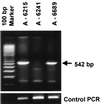Wild-derived inbred mice have a novel basis of susceptibility to polyomavirus-induced tumors
- PMID: 10559322
- PMCID: PMC113059
- DOI: 10.1128/JVI.73.12.10079-10085.1999
Wild-derived inbred mice have a novel basis of susceptibility to polyomavirus-induced tumors
Abstract
Polyomavirus induces a broad array of tumors when introduced into newborn mice of certain standard inbred strains, notably those bearing the H-2(k) haplotype. Susceptibility in these mice is conferred by an endogenous mouse mammary tumor virus superantigen (Mtv-7 sag) that acts to delete T cells required for polyomavirus-induced tumor immunosurveillance. In the present study we show that mice of two wild-derived inbred strains, PERA/Ei (PE) and CZECH II/Ei (CZ), are highly susceptible to polyomavirus but carry no detectable Mtv sag-related sequences and show no evidence of Vbeta deletion. C57BR/cdJ (BR) mice, which are H-2(k) but lack the endogenous Mtv-7, are highly resistant based on an effective anti-polyomavirus tumor immune response. When crossed with BR, both PE and CZ mice transmit their susceptibility in a dominant fashion, indicating a mechanism(s) that overrides the immune response of BR. Susceptibility in PE and CZ mice is not based on interference with antigen processing or presentation since cytotoxic T cells from BR can efficiently kill F(1)-derived tumor cells in vitro. The expected precursors of polyomavirus-specific cytotoxic T cells are present in both the wild inbred animals and their F(1) progeny. These findings indicate a novel basis of susceptibility that operates independently of endogenous superantigen and prevents the development of tumor immunity.
Figures



Similar articles
-
Susceptibility to polyomavirus-induced tumors in inbred mice: role of innate immune responses.J Virol. 2002 Oct;76(19):9657-63. doi: 10.1128/jvi.76.19.9657-9663.2002. J Virol. 2002. PMID: 12208944 Free PMC article.
-
Immunity to polyomavirus infection: the polyomavirus-mouse model.Semin Cancer Biol. 2009 Aug;19(4):244-51. doi: 10.1016/j.semcancer.2009.02.003. Epub 2009 Feb 14. Semin Cancer Biol. 2009. PMID: 19505652 Free PMC article. Review.
-
Susceptibility to tumors induced by polyoma virus is conferred by an endogenous mouse mammary tumor virus superantigen.J Exp Med. 1995 May 1;181(5):1683-92. doi: 10.1084/jem.181.5.1683. J Exp Med. 1995. PMID: 7722447 Free PMC article.
-
Resistance to polyoma virus-induced tumors correlates with CTL recognition of an immunodominant H-2Dk-restricted epitope in the middle T protein.J Immunol. 1998 Feb 15;160(4):1724-34. J Immunol. 1998. PMID: 9469430
-
Pathogen-host standoff: immunity to polyomavirus infection and neoplasia.Immunol Res. 2004;29(1-3):139-50. doi: 10.1385/IR:29:1-3:139. Immunol Res. 2004. PMID: 15181277 Review.
Cited by
-
Antiviral CD8+ T cell responses in neonatal mice: susceptibility to polyoma virus-induced tumors is associated with lack of cytotoxic function by viral antigen-specific T cells.J Exp Med. 2001 Mar 5;193(5):595-606. doi: 10.1084/jem.193.5.595. J Exp Med. 2001. PMID: 11238590 Free PMC article.
-
Susceptibility to polyomavirus-induced tumors in inbred mice: role of innate immune responses.J Virol. 2002 Oct;76(19):9657-63. doi: 10.1128/jvi.76.19.9657-9663.2002. J Virol. 2002. PMID: 12208944 Free PMC article.
-
Lessons from polyoma middle T antigen on signaling and transformation: A DNA tumor virus contribution to the war on cancer.Virology. 2009 Feb 20;384(2):304-16. doi: 10.1016/j.virol.2008.09.042. Epub 2008 Nov 20. Virology. 2009. PMID: 19022468 Free PMC article. Review.
-
Endogenous MMTV proviruses induce susceptibility to both viral and bacterial pathogens.PLoS Pathog. 2006 Dec;2(12):e128. doi: 10.1371/journal.ppat.0020128. PLoS Pathog. 2006. PMID: 17140288 Free PMC article.
-
Immunity to polyomavirus infection: the polyomavirus-mouse model.Semin Cancer Biol. 2009 Aug;19(4):244-51. doi: 10.1016/j.semcancer.2009.02.003. Epub 2009 Feb 14. Semin Cancer Biol. 2009. PMID: 19505652 Free PMC article. Review.
References
-
- Allison A C, Monga J N, Hammond V. Increased susceptibility to virus oncogenesis of congenitally thymus-deprived nude mice. Nature (London) 1974;252:746–747. - PubMed
-
- Berke Z, Wen T, Klein G, Dalianis T. Polyoma tumor development in neonatally polyoma-virus-infected CD4−/− and CD8−/− single knockout and CD4−/−8−/− double knockout mice. Int J Cancer. 1996;67:405–408. - PubMed
Publication types
MeSH terms
Substances
Grants and funding
LinkOut - more resources
Full Text Sources
Molecular Biology Databases

